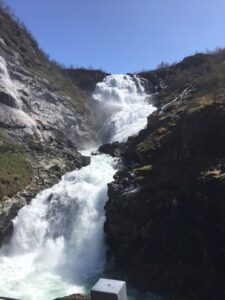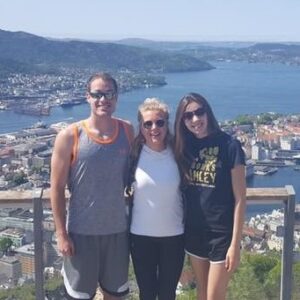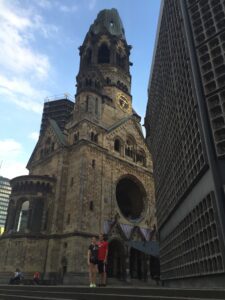Traveling Into History
Guest blogger Laura Schott is a recent college graduate who took her first-ever trip to Europe to visit her ancestral lands of Germany and Norway.
In the midwestern United States, one can expect to find people of two origins: German and Scandinavian. My fiancé and I, both from Fargo, North Dakota, and both recent University of Minnesota graduates, are no exception. Thanks to my dad’s 100 percent heritage, German dominates my own ancestry, but my mom’s side added some dynamism into the mix: I am roughly 75 percent German, 25 percent Norwegian, and a wee bit of Irish and French. My fiancé, Garret, basically has the same heritage, minus the French—here’s to hoping we’re not related!
College graduates head for the countries of their ancestors
As a graduation gift, Garret and I treated ourselves to our first European vacation where we would visit our “homelands” of Norway and Germany. Two of our very close friends accompanied us to Norway, which we visited first, and continued their journey north as Garret and I took off in the southwest direction for Part II of our adventure in Germany.
The four of us first flew from Minneapolis to Boston to Iceland to Oslo, where we stayed with Camilla, a former exchange student that one of our friends hosted during her senior year of high school. Camilla and her family proved to be excellent hosts. After waking up at 3 a.m. in Minneapolis, then taking three successive plane rides, we arrived at their home in Asker (just north of Oslo) to an incredible smorgasbord of breakfast foods.
Different cultures, different foods
If the beautiful scenery on the train ride to Asker hadn’t already told me we weren’t in the U.S. anymore, the food certainly did. Before Hege, Camilla’s mother, served us coffee, she warned that it would be quite a bit stronger than we were used to. When she visited her daughter in Minnesota a few years ago, she said that she’d been continually surprised (and disappointed) to find that American coffee tasted like water to her. I braced myself before taking the first gulp, and, while it was indeed strong, I proudly finished my mugful.
I didn’t ask for a refill, though.
Throughout the meal, it became apparent that Europeans are much more conscious of the freshness and authenticity of their foods than we are in America. We drank smoothies that were made entirely of fruit (no added sugar), a variety of goat cheese and cold cuts, and bread that was simply amazing.
I’m not sure quite how to describe it, but I think that Jenia, who would later be our host in Berlin, summed up the difference between American and European bread quite accurately: “Sorry, guys, I can’t do American bread,” she said, shaking her head and scrunching up her nose. “It just tastes artificial to me.” We assured her that there was no reason to be sorry—we agreed wholeheartedly and were not looking forward to returning to American bread ourselves!
Vikings and Vigeland
After we slept off our jet lag, we were able to start exploring Norway. We began by spending a day in Oslo, where we visited a Viking museum that reminded me of the Hjemkomst Center in Moorhead, Minnesota. The highlight of the Hjemkomst Center is an exhibit devoted to Robert Asp, a former guidance counselor at Moorhead Junior High School.
Like many Minnesotans, Asp was proud of his Norwegian heritage, but he took his pride to the next level. Asp’s dream was to build a replica of an ancient Viking ship and sail it—all the way to Norway. Asp began plotting his endeavor in the summer of 1971.
Unfortunately, he passed away before his ship could set sail, but his Norwegian spirit, work ethic, and determination lived on in his children and friends who’d helped get the project underway. These friends and family members sailed the ship all the way to Norway in Asp’s honor. The crew of 12 was greeted by their families and honored by a hero’s welcome by the people of Bergen, Norway, on July 19, 1982. As a Midwesterner who was well acquainted with Asp’s story from many school field trips to the Hjemkomst Center, I felt an immediate connection with the Viking Ship museum, and later when we visited Bergen, the Hjemkomst’s landing site.
Camilla took us to some of Oslo’s best-known sites. We took a stroll through Vigeland Park, which is the most enigmatic sculpture park I’ve ever seen. It consists entirely of naked people cast in bronze, granite, and cast iron. These 200-some figures, all crafted by the sculptor Gustav Vigeland (1869–1943) attract a whopping one million visitors every year.
I don’t know what motivated Vigeland’s vision, and nor, to my knowledge, does any historical society in Oslo. There were no informational signs explaining the motive behind Vigeland’s crowning work.
 Experiencing places in a new way
Experiencing places in a new way
This lack of signage was a difference we continued to notice throughout our trip. In America, it seems that if something has even the slightest claim to historical significance, it is accompanied by a sign giving eager viewers the background of what that thing is made of, the geographical region from which said material comes, the person who created/led/died in it, and the names of every person who may have influenced said person. And, of course, the thing at hand has its own snapchat filter and at least a handful of hashtags associated with it. None of this buzz seemed to exist in Norway; a site exists to be experienced in the moment rather than tweeted about.
We also came across this lack of informational signage and brochures during our Norway in a Nutshell tour, which I could not recommend more. It took us through the very different parts of Norwegian countryside—high, low, cold, hot, wet, dry, but ALL beautiful. As someone who loves to learn about the history of place, I was at first disappointed that Norway’s tourism had less to offer than America’s bombardment of information. However, as I stood between mountain peaks and felt the cool, wet air of an ancient waterfall rush past me, I realized that, sometimes, the best way to fully know a place is without the written word—a tough conclusion for me to come to.
But, one can always write about the experience of place later. 🙂
New places, familiar names
If someone told me that I was going to find a shop that was called anything close to my German last name, Schott, on my European adventure, I would have guessed it’d be in Germany. For this reason, I had to do a double take when I saw it on a storefront in Bergen. And then I realized it wasn’t quite Schott, but Scjhott, a Norwegian surname that has identified a philologist, writer, and competitive sailor, just to name a few figures. Even though it wasn’t quite the same name, and the chances that I’m related to any member of the cast of characters who donned the name Schjott in their lifetime is slim, it was still a cool almost-connection. So, naturally, I had my photo taken with it.
Berlin: A world of its own
Garret and I were sad to leave Norway, but Garret couldn’t wait to land in Berlin at the airport that a scene in Captain America: Civil War (which had recently skyrocketed to the top of his favorite movies list) was filmed. When we landed, it was clear to both of us that the airport was not the same as the one in the movie, and we both felt a bit naive for thinking that Berlin only had one airport like our hometown in North Dakota. We soon learned that Berlin has not only everything you could dream of in a city, but multiples of everything. Our host, Jenia, shared Berlin’s city saying with us: “Born in Berlin, live in Berlin, die in Berlin.”
“There’s no reason for people to leave,” Jenia said as we walked through Tiergarten. “Which in some ways is good, because they have everything they need here, but it also discourages people from experiencing other cultures.”
People have clearly brought many different cultures to Berlin, though. In Bergmanstrasse alone, one can find restaurants that represent about ten different countries’ cuisines along only one street. Jenia and her boyfriend, Maik, took us to their favorite Mexican restaurant while we were there.
“We’re a bit nervous taking you to a Mexican place, as you guys are so much closer to Mexico!” said Jenia. But Garret and I, starving from walking around the city all day, scarfed down our food gratefully. It seemed to me that it was almost more authentic than American Mexican food, despite our proximity to Central America. Maybe this has something to do with us living in the Midwest, or maybe it circles back to America’s love for artificial ingredients.
Haunted in Berlin
When you’ve spent your whole life in a country as young as America, your idea of what constitutes an old building is very different from the rest of the world’s. I think that, because I grew up in a place where something that’s been around since the 1800s seems ancient, the sheer age of the buildings, structures, and even streets of European cities was a bit of a shock for me. I didn’t feel this shock quite so strongly in Norway, but in Germany it was a jarring experience. I think that this is definitely because of what happened in Germany, and everything that the country does to keep its recent, terrible history fresh in its citizens’ and visitors’ minds.
It is a very chilling experience to read about someone getting shot while trying to make their escape over the Berlin Wall, and realizing that they died right where you stood. Right where you’re reading about them as a free, American tourist.
It is also chilling to walk through beautiful courtyards of former apartments, now filled with theaters, specialty shops, and happy couples out for a stroll, and to realize that these apartments were once home to an entire Jewish community—all of whom were forcibly removed from these homes; probably dragged across the brick path that melty gelato drops now fall on from the hands of tourists like myself.
I felt haunted in Berlin, and in Bavaria, where we visited Dachau, the first and longest operating concentration camp in Germany. I think that some land is so deeply affected by the horror that occurred on it—like the soil itself is stained by atrocities that cannot be escaped nor forgotten.
But I suppose that’s kind of the point, isn’t it? The goal of the Dachau memorial site and museum as it is today is to “preserve the memorials as evidence of the crimes of National Socialism, as sites of remembrance of the victims’ suffering and as sites of learning for future generations.”
Traveling into history
While I was still a full-time college student, not knowing if or when I’d have the time or resources necessary to travel, I put a lot of thought into whether or not I’d want to make traveling a priority in my future.
This may sound strange—I mean, who wouldn’t want to travel? But I wanted to reflect on my motives behind traveling. What was I hoping to get out of it? Did I want to travel to learn about other cultures; experience history first-hand; and challenge myself to expand my worldview, which (at the time) consisted of 18 to 20 years of American life? Or, did I simply want to take time off from work, responsibilities, and treat myself to a vacation?
I think that my time in both Norway and Germany helped me realize that the most enriching trips are those that allow you to meet people whose different lifestyles can inform and challenge your own. They’re the trips that allow you to be humbled by the kindness of strangers who open their homes to you without hesitation; the trips that inspire you to return the favor for someone else one day.
I also think that the most enriching trips are the ones that bring you close to history. Whether that history is familial, social, natural, or political, there is something about being present in a place that’s impossible to get out of just hearing or reading about it. And it’s not something I can put into words. It’s more of a feeling—I think that the experience of place is something that embeds itself deep into your person, and once it’s there, for better or worse, you couldn’t dislodge it even if you wanted to.




